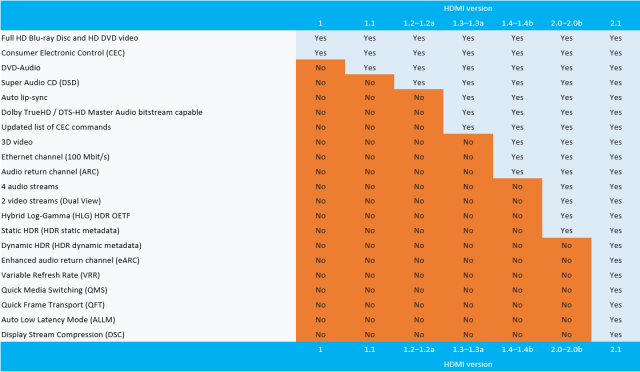Back in January, the HDMI Forum—the trade association that develops the HDMI spec for video interconnects—outlined its plans for HDMI 2.1. That specification has now been finalized, giving a definitive view of what's in store for our video hardware.
In spite of a version number that suggests it's only a minor update, the spec represents a significant step up from HDMI 2.0. Underpinning everything is a new cable, the Ultra High Speed HDMI Cable, that supports data transfer rates of 48 gigabits per second. The new cables are backward compatible with older HDMI specs—they use the same actual plugs and sockets—but support substantially faster connections than the 18Gb/s of HDMI 2.0, let alone the 10.2Gb/s of HDMI 1.4.
What can you do with all that bandwidth? More resolution, higher frame rates, and more color depth. With the new cabling, HDMI can support uncompressed 4K video at up to 120 frames per second, with high dynamic range color with up to 12 bits per channel. Cut back in one or more areas and you can push further in others; limit your framerate to 30fps, and the spec will support uncompressed 8K 12-bit video; use chroma subsampling and it can hit 60fps at the same resolution and color depth.
HDMI 2.1 also allows video streams to go beyond the 48Gb/s limit with a new feature called Display Stream Compression. This feature compresses the video stream on the fly, allowing for notional data rates of up to 128Gb/s, for chroma subsampled 120fps 12-bit HDR 8K video. And if 8K isn't enough pixels for you, there are a number of 10K formats supported for a 10,240×4,320 resolution, intended for specialized commercial applications.

Beyond the raw data rates, HDMI 2.1 also brings some extra features. Gamers will be interested in Variable Refresh Rate—essentially a standardized version of Nvidia's G-Sync and AMD's Freesync (which is itself a standardized feature of the DisplayPort connection standard), which alters the refresh rate on the fly to match the rate at which frames are produced by the GPU—and Quick Frame Transport, which somehow reduces the latency of the HDMI connection.
For cinephiles, High Dynamic Range (HDR) allows the display to alter its contrast and brightness on a frame-by-frame basis, and enhanced Audio Return Channel (eARC) ups audio support to uncompressed 7.1 and high bitrate positional audio systems such as Dolby Atmos and DTS:X.
Even with the spec complete, it's going to be a while before we actually see HDMI 2.1 hardware on the market. Over the next nine months, the HDMI Forum will release compliance tests, and only then would we expect to see it become available in shipping products. The range of new features means it's in some ways a mixed bag; few of us will feel any pressing need to upgrade to 8K and 10K video—even for 4K, the content ecosystem is in its infancy—but certain audiences would see immediate benefits from VRR and QFT, given video cards and monitors that support them.
[contf] [contfnew] 
Ars Technica
[contfnewc] [contfnewc]























































